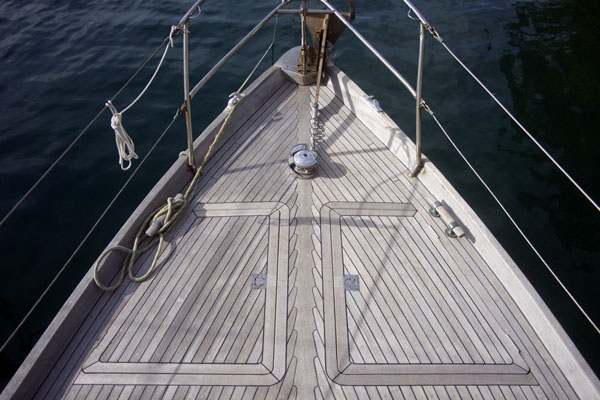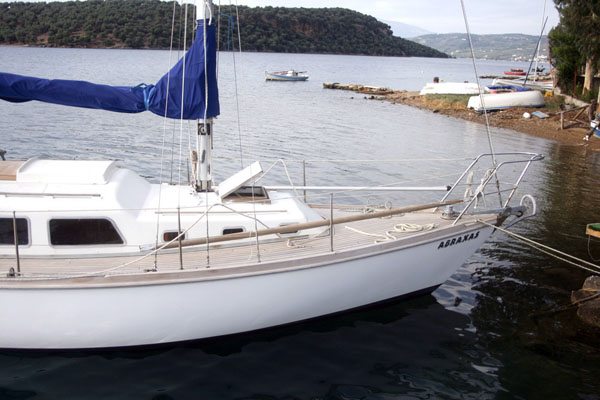Advertisement
Advertisement
Teak Deck Care and Feeding
Teak decks are beautiful and practical, but they require special care to look and perform their best.
March 27, 2020
There’s no getting away from how good teak looks on the outside of a boat, especially one with acres of teak decking like the Oyster 825. Given that teak provides unbeatable grip, even when wet, there are ways in which having teak decks is practical.

Not only do teak decks look gorgeous on a boat, they are also practical.
Although it’s a potentially durable material for marine use, the teak used in decking can quickly deteriorate if not cared for correctly, leaving the owner with a significant bill for repair or replacement. Don’t underestimate this; a new teak deck for a 40-foot boat will cost upwards of $30,000 (and it’s a bill that all too frequently comes as an unpleasant surprise to the owner).
The biggest problem is that the gorgeous scrubbed look that we all see on photos of superyachts and classic vessels literally wears the deck away at up to one tenth of an inch of thickness each year. While the grain of the teak wood is very hard, the fibers between the grains are soft and are easily damaged with scrubbing. With some new decks measuring only a half-inch thick (and even the best being only three-quarters of an inch thick), it doesn’t take long to inflict potentially terminal damage.

It requires scrubbing to get this beautiful weathered look, but never scrub with the grain-always go across the grain of the wood.
The improvements in adhesives over the past fifteen years or so means that modern teak decks are generally not mechanically fastened to the boat with screws. This means there’s less risk of water finding its way into the deck’s foam or balsa core and causing significant structural damage. The downside is that these decks may also be thinner than those of older boats – in some cases as little as a quarter-inch thick.
Treat Teak Wood Gently
So what can be done to maximize the lifespan of a teak deck? The obvious answer is to avoid scrubbing the decks. For a boat kept in a sunny environment, all that’s needed is a regular wash with salt water. This technique also has the advantage of not stripping the natural oil out of the timber. After a few weeks, the decks will acquire a natural silver-grey patina. Although in the eyes of some observers this may not look as sexy as freshly scrubbed teak, it’s exactly what anyone searching for a second-hand yacht should be hoping to find. Unfortunately, in more temperate climates, teak decks may need more attention than this, but it still pays to be as careful and gentle as possible. If you have to wash the decks use light pressure on a very soft-bristled brush and always brush across the grain. This will minimize removal of the soft timber between the grain and significantly reduce the rate of wear. Using a stiff bristled brush, or worse still, a pressure washer, will maximize damage to the timber. It may feel as though these are quick routes to a clean deck, but this is also a quick route to a big boatyard bill that in many cases will amount to a significant proportion of the total value of the boat. If you really want a virgin teak look for special occasions, make sure you let the teak cleaner (which contains oxalic acid to bleach the timber) do as much of the work as possible. Again, patience is the key here; the less actual scrubbing you do the better. A generous application of teak oil will then help to maintain the appearance afterwards.
Surveying Teak Decks
Signs of a deck that’s in need of attention include loose caulking, movement of wooden plugs over screw heads, and splits or cracks in the timber. The more extensive these problems, the closer the decks are to the end of their useful life. Small problems are generally easy and quick to fix and are perhaps best done in fine weather during the summer, rather than waiting for a winter refit.

Loose caulking, missing or loosed plugs over screws, or cracks in the timber are all signs that the deck needs repair.
It’s always a mistake to ignore problems as they pop up because they can escalate surprisingly quickly until the only option is to replace the entire deck.
How to Repair Your Teak Deck
Providing it’s not waterlogged underneath, a deck that’s significantly worn and has damaged caulking can generally be given a new lease of life.
- Start by sanding the decks smooth.
- Cracks in the timber can be opened out with a small chisel or Dremel-type tool, then allowed to dry thoroughly before being filled with an epoxy-based filler.
- Loose caulking should be picked out, the affected area cleaned back to bare wood (ideally with a router), and the affected caulking replaced.
- With older decks that are screwed down, the teak plugs above the screw heads will eventually become thin and then fall out. This looks unsightly, but even worse, it provides a route for water to get into the structure of the deck. Luckily, the screw can usually be removed and its hole drilled out to a slightly deeper level. A new, thicker, teak plug can then be glued in place above the screw head.
- Next, remove all the caulking by using a router to make the groove between the planks slightly deeper than the original. This will give sufficient depth for new caulking to adhere successfully.
- Once the caulking has been applied the deck will need to be sanded again to get rid of the excess caulking compound.
If any other problems are sorted at this same time, this procedure can help a carefully looked after deck to last for a further five to 10 years, yet should cost a small fraction of a new teak deck. Effective boat maintenance can certainly save you money in both the short and long-term as the following features explain: Yacht Deck Fittings: Service and Repair Tips and How to Prevent Plywood Delamination: Sealing Exposed End-Grain.
Advertisement
Advertisement











